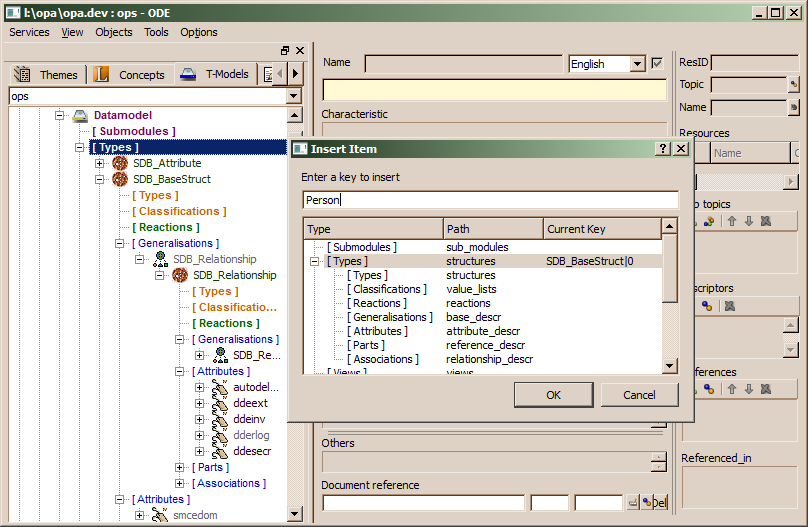Define object types
Terminology object types are usually concepts, which require a more detailed definition. Types can be created for each terminology model or module. In order to create a type you click on the Type item below the required model or module and select Insert.

After entering the type name and confirming, the type will be created in the list and can be described in the work space of the application. Types are described as documentation topics. Besides type definitions, terminology object types contain specific additional characteristics:
- Generalizations
- Attributes
- Parts
- Associations
- Keys
- Types
- Classifications
- Reactions
Each of those characteristics should be described in a separate documentation topic. Characteristics are identified by names. Names of characteristics within an object type must be unique and must differ from characteristic names in all generalizations of the object type.
A type generalization is a more general concept for the concept describes. Usually, generalizations result from the generalizations in the concept definition. For an object type, one or more generalizations might be defined.
Generalizations correspond to base types in the data model. When upgrading a terminology model object type to a complex data type, generalizations automatically become base types.
Generalization require an object type describing the characteristics of the object type. Moreover, reactions might be defined for a generalization.
When creating an terminology object type from a concept definition, its generalizations should be turned into object type generalizations automatically. This is not yet the case and one has to do this explicitly.
Attributes are specific characteristics of an object type. Attributes are inseparable connected with the object type. Some applications distinguish between identifying, categorical and quantitative attributes, which is not supported by terminus.
Attributes correspond to attributes in the data model. When upgrading a terminology model object type to a complex data type, terminology attributes automatically become attributes of the complex data type.
Attributes usually refer to an object type describing the characteristics of the attribute (complex attribute) or to a simple data type. Moreover, reactions might be defined for an attribute.
Parts of a terminology object type are complex objects that belong to objects of the given type. Those objects usually have got an own terminology object type.
Typically, parts correspond to references in the complex data type, but sometimes. parts also might become attributes.When upgrading a terminology model object type to a complex data type, parts automatically become references.
Parts usually require an object type describing the characteristics of the objects being defined as parts. Moreover, reactions might be defined for a part.
Associations describe links between independent objects. The association itself is integrated part of the object, but not the associated object. Typically, associations are bidirectional.
In the data model, associations correspond to relationships. When upgrading a terminology model object type to a complex data type, associations automatically become relationships.
Associations require an object type describing the characteristics of the objects being associated. Moreover, reactions might be defined for an association.
Keys define subsets of attributes from the object type and its base types, which are used for identifying, locating or ordering objects. The concept of keys is similar in the data model and in the terminology model, i.e. when upgrading the object type to a complex data type, keys remain keys.
Terminology objects may refer internally to object types known in the context of the current terminology object type, only. Usually, internal types are not defined while building the terminology object but while extending the terminology model during implementation.
In the data model, local object types correspond to complex data types in the class namespace. When upgrading a terminology model object type to a complex data type, local object types automatically become complex data types.
Reactions allow defining the way an object behaves, when a certain event happens. Defining reactions is helpful in order to understand casual relationships in the subject area.
In the data model, reactions correspond to causalities. When upgrading a terminology model object type to a complex data type, reactions automatically become causalities.
The causality model is not yet implemented completely. Inform us, please, when you are going to make use of it.

